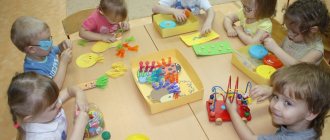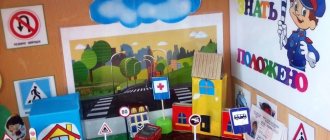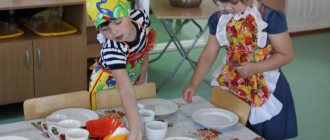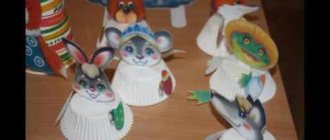Subject-based developmental environment in early age groups - presentation
Modern approaches to the formation of a subject-based developmental environment in preschool institutions The direction of a child’s activity and development largely depends on us, adults - on how the subject-spatial organization of their life is structured, what toys and teaching aids it consists of, what their developmental potential is, and even on how they are located. Everything that surrounds a child shapes his psyche and is the source of his knowledge and social experience. Therefore, it is we, teachers, who take upon ourselves the responsibility to create conditions that would contribute to the most complete realization of children’s development in all psychophysiological parameters, i.e. organization of the subject-spatial environment.
The developing environment is a unity of social and natural factors that can influence directly or indirectly, instantly or long-term on the life of a child (i.e., the social culture of society, in fact, this is the world into which a child comes when he is born). A developing subject environment is a system of material objects of a child’s activity, which in turn models the content of the child’s spiritual and physical development. Thus, the subject-spatial environment is an integral part of the developmental environment of preschool childhood.
Particular importance in preschool institutions is attached to an object-based play environment, since the main activity of the child is play and its influence on the comprehensive development of the individual cannot be overestimated. The concept of “subject-game environment” is a component of the “developing subject environment”.
Objectives of the development environment Protection and strengthening of the physical and mental health of children, their physical development; Protection and strengthening of the physical and mental health of children, their physical development; Emotional well-being of each child; Emotional well-being of each child; Intellectual development; Intellectual development; Creating conditions for personal development; Creating conditions for personal development; Introducing children to universal human values; Introducing children to universal human values; Interaction with the family in order to optimize the educational process. Interaction with the family in order to optimize the educational process.
Components of the development environment Social component Mutual understanding and satisfaction of all subjects with relationships. Spatial-subject component Integrated environment for the comprehensive development of the child Psychodidactic component Pedagogical support for the child’s developmental capabilities
Basic principles of building a developmental environment 1. The principle of positional distance during interaction - focused on organizing a space for communication between an adult and a child 2. The principle of activity - this is the possibility of joint participation of an adult and a child in creating the environment 3. The principle of stability - dynamism - focused on creating conditions for change according to taste, mood and possibilities. 4. The principle of integration and flexible zoning - realizes the possibility of constructing non-overlapping spheres of activity and allows children to simultaneously engage in different types of activities without interfering with each other. 5. The principle of combining conventional and extraordinary elements is the aesthetic organization of the environment. 6. The principle of “gender and age” differences realizes the opportunity for girls and boys to express their inclinations in accordance with the norms accepted in our society 7. The principle of freedom for a child to achieve his right to play. 8. The subject-spatial environment should be oriented toward the zone of “proximal development.”
For young children, the main directions of development are: changing the leading motives of activity; development of emotional, business and substantive communication; development and activation of general movements; development of objective actions and objective activities; development of visual and effective thinking; intensive accumulation of passive vocabulary, stimulation of active speech; mastering various skills in the process of imitation; formation of self-image; formation of prerequisites for constructive and visual activities; activation of independence in everyday life and the formation of the need for recognition of one’s own achievements; strengthening self-care skills; development of inner speech.
4 main types of child activities: play; productive; cognitive and research; motor.
Developmental environment of early age groups in kindergarten 5. Nursery. The didactic table in early age groups is indispensable. In one place, various kinds of toys and materials are concentrated, different in the direction of development of the child’s actions.
Multifunctional aid - airplane Used as play equipment for plot-based games, as well as an original and convenient shelf for placing aids.
Constructive activity corner The variety of construction sets and their convenient placement makes this area very attractive for children.
Rational placement of toys allows the child to freely choose those that are interesting to the baby at a given time. It is very important to take into account the variety of toys, their texture, size, and purpose.
We play with dolls. In this play area, a child learns the basics of adult life. The more material there is to play out, the more independent life situations that are simulated. How interesting it is for a child to play the role of an adult. This gives him confidence and teaches him how to live as an adult.
Young children love all toys that rattle, ring, and make noise. This is sometimes inconvenient for adults, but nevertheless, all these noisy toys develop the baby. Therefore, it is necessary in an early age group to find a place to place children’s musical instruments. It would not be superfluous to create a mini-dressing room, or a dressing room. This will not only add originality to the educational process, but will also allow the small child to independently resolve some issues.
Artistic and speech zone The book corner is adjacent to the “noise” toys corner. The filling of the book corner is diversified by the introduction of various types of theaters. It’s great when the group has and uses a music center. Creative activity begins at an early age. Music and literature contribute to the development of creative abilities.
Motor activity corner Mobiles and machines not only help organize plot-based play, but also serve as an additional means of stimulating movements at an early age. The use of massage mats and non-standard sports equipment creates interest in physical education.
First junior group In this group, many mini-zones are compactly assembled on a large and spacious shelf. Some of them require children to directly contact the teacher.
Musical instruments, theatrical figures, and visual aids form the creative activity of a 3-year-old child.
Corner of sensory development Benefits for every taste - pyramids, inserts, sleeves, button holders, lacing. All this develops manual skills and contributes to enriching sensory experience.
Physical activity corner Sports equipment should be located within the child’s reach. In this case, bright, light baskets containing balls, ring throws, and pins were chosen very well. Multifunctional mats made by teachers are indispensable for massaging the feet.
Artistic and speech zone A relaxation corner where you can sit quietly and leaf through an interesting book, which the teacher will kindly serve at the child’s request.
Next to the book corner there is a zone of cognitive activity - a corner of board and printed games. It’s nice to sit at a table covered with a beautiful tablecloth in comfortable chairs and solve tasks offered by board games. Books that contain tasks for the development of mental processes, as well as games, contribute to the development of the child’s cognitive sphere.
"Doll's room" Living room. Kitchen.
In the doll corner there is a manual for the game “hairdresser”. In this case, it is presented both in this capacity and as a dressing area. The versatility of this manual allows it to be used in different areas.
Developmental environment of early age groups in school 1. (state farm) The color scheme, brightness of colors, and wall decoration are also part of the child’s developmental environment, as they affect the comprehensive development of the baby through sensory education and the formation of aesthetic taste.
The use of textile materials in the design of a group not only performs the function of separating play areas, but also creates coziness in the room, creating a homely atmosphere.
Motor activity corner Filling the corner with toys - engines, a multi-colored slide, gurneys, non-standard equipment stimulates the child's motor activity; competent guidance from the teacher will allow targeted and effective action on all muscle groups.
“Sensory” corner Didactic aids located in this play area correspond to the age characteristics of children. Their diversity stimulates the child’s cognition and forms the concept of sensory standards. Sensory play is extremely important at an early age, as sensory development is the foundation of mental development.
Multifunctionality of benefits What is it? There are many answers. This is a big plus. This corner allows you to diversify the child’s role-playing game.
Multifaceted corner This corner combines different types of activities - from cognitive-experimental to artistic-creative. Such proximity does not interfere with the child’s choice of activities according to his interests.
Game corner
The play corner consists of several parts: kitchen, dining room, room, bedroom. Strollers, playpen and other toys are included.
Developmental environment of an early age group in school 1. Nursery. Rational placement of games and aids allows the teacher to diversify the actions of children with objects
Pyramids, lacing, and various construction sets help solve the problems of both sensory education of children and the development of fine motor skills.
A doll corner, decorated in the same style, cultivates aesthetic feelings, and also contains the entire complex of children's play furniture.
A theatrical area for games in early age groups stimulates the development of a child’s speech and has a beneficial effect on the formation of the emotional sphere.
A variety of benefits for the physical education of children.
Soft pillows of different shapes and colors encourage your baby to relax and create a cozy atmosphere. A house for privacy with windows and doors, just like a real one. This is where there is scope for the development of display play.
A large selection of toys has a positive effect on the mental development of children. A book corner located at the height of the child allows you to easily select the book you like.
The theoretical basis for organizing a subject-developmental spatial environment for young children was the research of T. N. Doronova, N. A. Korotkova, N. M. Aksarina, as well as regulatory documents of SanPiN. A skillfully organized environment reduces conflict in children’s communication with each other by more than 50%, and relieves anxiety in the absence of a close adult. Children adapt faster to a group of peers. They become interested in kindergarten and want to be with their peers
This presentation is the work experience of teachers of early age groups: Dvornikova V.L. Gnevysheva V.A. Belovol A.S. Makarova N.V. Kryzhopolskaya N.N. Uglanovoy P.Yu. The manual is recommended for preschool teachers. This presentation is the work experience of teachers of early age groups: Dvornikova V.L. Gnevysheva V.A. Belovol A.S. Makarova N.V. Kryzhopolskaya N.N. Uglanovoy P.Yu. The manual is recommended for preschool teachers. Compiled by: Dvornikova V.L. – head of the Ministry of Defense
Subject-spatial environment in the second group of early age 2019-2020
Municipal budgetary preschool educational institution of a combined type, North Yenisei kindergarten No. 4 “Zharki”
Analysis of the developing subject-spatial environment
in the second early age group 2019-2020
Educator: Sagdatdinova R.I.
Relevance
The issue of organizing the subject-developmental environment of preschool educational institutions is particularly relevant today. This is due to the introduction of the new Federal State Educational Standard (FSES DO).
In the requirements of the Federal State Standard, the subject-spatial environment is designated as one of the key conditions for a successful educational process. And the creation of a subject-spatial developmental environment that meets the requirements of the Federal State Educational Standard is a key task of preschool organizations. The subject-spatial environment should stimulate children to be active in various types of activities and develop abilities. The developing subject-spatial environment of a preschool institution is an important component in the development of a child. The child’s activity depends on how the object-game organization of his life is structured.
"Subject development environment"
- this is a system of material objects of a child’s activity, the content of his spiritual and physical development, this is the unity of social and objective means.
A properly organized developmental environment in the group allowed each child to find something to their liking and to believe in their strengths and abilities. It is not the adult, but the objective world that encourages the child to take independent active actions.
According to the Federal State Educational Standard for preschool education, the content of the educational program must ensure the development of the personality, motivation and abilities of children in various types of activities and covers the following structural units, representing certain areas of development and education of children:
- Social and communicative development;
- Cognitive development;
- Speech development;
- Artistic and aesthetic development;
- Physical development.
The types of activities of preschool children within each educational area can be implemented based on the potential of the developing subject-spatial environment of the preschool educational institution with appropriate content.
In accordance with the principles discussed, the following subject-development environment was created in the second group of the Forget-Me-nots early age group:
Social and communicative development:
- Center for role-playing games “Play”;
- Solitude corner.
Cognitive development:
- center for educational games "Znayka";
- ;
- center for board and printed games “Pochemuchka”;
- .
Speech development:
- center for theatrical activities “Visiting a Fairy Tale”;
- Corner "Mumming".
Artistic and aesthetic development:
- .
Physical development:
- . Social and communicative development
:
- Center for role-playing games “Play”;
When creating an object-based play environment in a group, we take into account certain requirements: this is, first of all, the freedom for the child to achieve the theme and plot of the game.
Corner of solitude
- this is a means designed to facilitate the process of a child’s adaptation to a new team, walls, and daily routine. A corner of solitude is a place in a group where a child feels completely safe, where he can escape from stressful events.
Cognitive development:
- center for educational games "Znayka";
- ;
- center for board and printed games “Pochemuchka”;
- .
Center for educational games "Znayka".
The center for educational games is aimed at developing speech, sensory perception, fine motor skills, and imagination.
.
The “Water and Sand Center” in our group helps organize children’s cognitive and research activities. We are talking about playing and experimenting with various objects and natural materials. By organizing games with water and sand, we not only introduce children to the properties of various objects and materials, but also help them consolidate ideas about the shape, size, color of objects, develop fine motor skills, and lay the foundation for learning to design (molding from sand).
Center for board and printed games "Pochemuchka".
The play area contains a variety of games for children, taking into account age and gender education.
Goal: Development of fine and gross motor skills in children of the younger group. Sensory development is, first of all, the development of its perception and the formation of ideas about the external properties of objects: their shape, color, size, position in space.
Speech development:
- center for theatrical activities “Visiting a Fairy Tale”;
- Corner "Mumming".
Center for theatrical activities.
The Theater Activity Center is one of the active sectors in our group; its goal is: Development of creative abilities in children; Development of imagination, ability to improvise; Development of memory, attention, expression of basic emotions; Instill a sustainable interest in literature, theater, music; All costumes and attributes are arranged so that it is convenient for children to take them and use them, and they will unite in subgroups based on common interests. In the corner there are props for various types of theater: finger theater, tabletop, flat.
Corner "Mumming".
In our group there is a corner that all children, without exception, love. Everyone chooses their own image, according to their sympathies and feelings living in their soul here and now. This provides psycho-emotional release and lifts your spirits. They study the purpose of things and their seasonality. They choose their own image.
Equipment:
Mobile shelf cabinet for storing costumes, exhibition stand, screen, modules, masks, costumes, ribbons, capes, hats, scarves, bags, attributes for fairy tales.
Book Center.
The most accessible and effective way to develop children is reading. The educational potential of a children's book is limitless. Thinking, speech, memory, attention, imagination - all this is formed through communication with a book.
Equipment:
library of fiction, illustrations for works, subject and subject pictures, portraits of children's writers, didactic games
Artistic and aesthetic development:
.
The main goal of this center is to develop the creative abilities of preschool children.
Physical development.
One of the basic needs of early childhood is the need for movement. For this purpose, physical education equipment has been selected in the sports corner, which encourages children to be physically active and gives them the opportunity to diversify their movements. In the corner there are various materials: balls, hoops, multi-colored flags, ribbons, plumes. And bags filled with sand, peas, cereals, rings, massage paths are used for walking, stepping over, jumping. A variety of bright toys and objects are also used, which are an incentive to perform a variety of movements. The equipment corresponds to the age characteristics of children. The equipment is placed in such a way as to stimulate physical activity and encourage interesting and feasible actions.
Conclusion:
Thus, the developing object-spatial environment I created for young children, first of all, performs an informational function in relation to them; each object carries certain information about the world around them and becomes a means of transmitting social experience. Serves the interests and needs of the child, enriches the development of specific types of activities, provides the child’s zone of proximal development, encourages them to make conscious choices, put forward and implement their own initiatives, make independent decisions, develop creative abilities, and also shape the personal qualities of preschoolers and their life experience, i.e. e. ensures the full development of the child’s activity and personality.
Manager
MBDOU No. 4 “Zharki” _______________________ G.I. Lopateva
2





